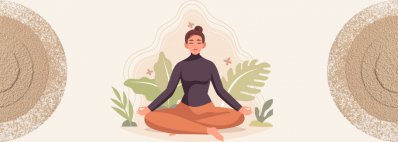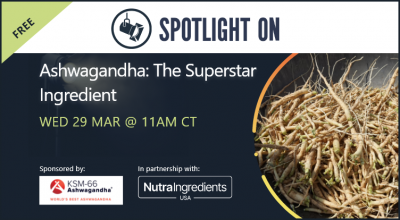Promotional Features
Introducing Ashwagandha Insights
Launching Ashwagandha Insights
Introducing the Ashwagandha Insights Initiative
Ashwagandha Insights is a new initiative that aims to bring fresh in-depth content designed to help brand owners and formulators make intelligent, well-informed decisions in the rapidly growing Ashwagandha category. This initiative is an outcome of a partnership between Nutraingredients and KSM-66 Ashwagandha.
Ashwagandha continues to surprise with its growth
Ashwagandha (Withania somnifera Dunal) is one of the world's best known and relied-upon adaptogens, used for centuries to help support the body's natural balance for robust well-being and health. Interest in ashwagandha has been rapidly increasing. Data from Google Trends indicate that internet searches for ashwagandha globally have doubled over the last 24 months. The growth in interest in ashwagandha has been even more remarkable in the United States, with internet searches there doubling over the recent 16 months. The herb has been particularly popular during the COVID-19 pandemic because it has been advocated for immune-boosting and stress-relieving properties, but the demand for ashwagandha was rapidly growing even before COVID-19. Veteran industry observers believe the pandemic accelerated already increasing interest in ashwagandha, and that this herb is poised for continued growth in global demand.
Growth unfortunately can bring risk from profit-chasing suppliers
While rapid growth in demand for an ingredient should be exciting to brand managers and end-product manufacturers, they should recognize that such growth can put intense pressure on the supplier marketplace and bring unwelcome consequences. A pattern, played out in the past with other product categories that experienced similarly rapid growth, is that new suppliers often see an opportunity to increase revenue and do the proverbial jumping on to the bandwagon. Such entrants, even if known for other products, may not have the expertise or history in the emerging category as do the market leaders who created the category in the first place. Perhaps to offset this disadvantage, the new entrants often introduce new factors or claims of superiority. This flood of claims and new marketing communication can confuse brand owners and obfuscate the important drivers of efficacy. This in turn can increase the risk that brand managers make regrettable decisions they would not have made if they had understood supplier differences well in the first place.
Kartikeya Baldwa, CEO, KSM-66 Ashwagandha: “KSM-66 served as the beachhead to make ashwagandha become the large category product that it is now. Being a major driver of growth in this space, we feel it our responsibility to ensure that there is dissemination of accurate knowledge about ashwagandha ... This is needed especially now when there is a spurt of suppliers without substantial history or expertise in ashwagandha entering this market to capitalize on the growing demand.” |
Beyond the threat of confusing and distracting information, there is also the potential threat of what the Natural Products Association has called “economic adulteration", where supplier firms may be “replacing expensive ingredients with less safe and less costly ingredients”. This is a concern particularly for ingredients where the raw material is relatively expensive in the first place. For such ingredients, brand owners have a greater temptation to go with cheaper alternatives and the information obfuscation from suppliers can distract brand owners from the important value drivers.
Forewarned is forearmed, as the saying goes, and so perhaps the best defense that brand owners and formulators can use to combat suppliers' information obfuscation is to become more savvy and aware about what differentiates the various sources of ashwagandha in the marketplace. The aim of the "Ashwagandha Insights" initiative is to arm you with exactly this kind of information, to dispel misconceptions created by any marketing hype of suppliers. The initiative is launched by two very credible entities, Nutraingredients and KSM-66 Ashwagandha, who came together with a shared mission of empowering brands and formulators with accurate and timely knowledge on the nuances of ashwagandha applications and sourcing. This is a natural partnership, with Nutraingredients well known for its high quality, erudite journalism and analyses in the natural products space, and KSM-66 Ashwagandha being a major enabler in bringing ashwagandha to wide visibility in Europe and North America.
The discriminating reader will wonder, Why the need for new content on ashwagandha, when one already hears so much about it? The goal of this series is not to produce merely an introductory account on ashwagandha, but more of an in-depth account, going into issues and considerations that the typical reader is unlikely to have come across before. We want to separate out what is merely faddish or hyperbolic about ashwagandha and focus on what is genuinely different about it with a competitive, distinguishing advantage. We also want to help formulators and brand owners become more intelligent in choosing ashwagandha suppliers and in recognizing marketing hype where it exists.
What Ashwagandha is
Ashwagandha is the flagship herb of Ayurveda, an ancient modality of healing that consumers have rediscovered. Ashwagandha is poised to experience increased global demand. For the last few years, mainly in the US and European markets, ashwagandha has gained an ardent consumer following, due in considerable measure to a battery of new clinical research and extensive education by the category champion,KSM-66 Ashwagandha. Ashwagandha is likely to remain a coveted botanical supplement with projections of even more demand in the foreseeable future. The herb has become popular during the COVID pandemic because it has been advocated for immune-boosting and stress-relieving properties. Consumers worldwide associate “general health and wellness” with adaptogens, as this class of herbs provides just that. According to consumer research by New Hope Network NEXT Data and Insights survey of 1,000 U.S adults (August 2, 2020), the number-one reason for consuming supplements is “general health and wellness,” (54%).
Ashwagandha has been documented to have a surprisingly broad range of effects. Many research studies indicate ashwagandha can lower levels of serum cortisol, what is often called the "stress-hormone", and make people feel better, sleep better and feel less anxious. While stress reduction is talked about as a common benefit of ashwagandha, the science-backed benefits of this herb go well beyond. Studies show ashwagandha to lead to improved cognitive function for memory and information processing speed. Studies suggest also that ashwagandha root extract can boost energy, improve sports performance, increase muscle strength, reduce muscle damage and accelerate muscle recovery. The literature documents ashwagandha root supplementation in human males leading to increased testosterone levels, luteinizing hormone, vitality, and human females leading to improved orgasm and sexual satisfaction. Studies speak also to anti-aging effects of ashwagandha.
Some worries about the Ashwagandha Supplier Marketplace
While ashwagandha has been exciting for formulators and brands, there is also reason to be extra cautious and vigilant. The sharp increase in demand for ashwagandha has put pressure on supply and there is strong concern that there may not be enough high-quality supply to meet this demand. There is already suggestive evidence of this in the last few months with an approximate 250% increase in the pricing of the ashwagandha root, which is the most coveted and widely sought part of the plant. There is strong concern that some suppliers eager about profit-chasing are using the leaves, which are much cheaper and have much less support in ashwagandha’s body of published research, monographs and reference works. The Botanical Adulterants Prevention Program (BAPP) recently published its "Ashwagandha Root and Root Extract Bulletin" drawing attention to some suppliers engaging in surreptitious substitution of the root constituents in ashwagandha with the plant's leaves and/or stems. The BAPP is a joint effort of three widely respected organizations: the American Botanical Council, the American Herbal Pharmacopoeia and the National Center for Natural Products Research. We should not be surprised by this compromise in quality and transparency by suppliers to the detriment of makers of end-consumer products. Decades of observation of the natural supplements show a pattern where natural ingredients and herbs that rise to the top of demand and consciousness often motivate opportunists to contribute inferior supply, eager to cash in.
Related to this is the Natural Products Association’s sounding the alert on what it calls "economic adulteration" that we referenced earlier (see https://www.npanational.org/news/npa-asks-fda-to-stop-fraudulent-products-from-entering-u-s/). One may think that a reliable way to recognize such “economic adulteration” is by looking at the price of the ingredient, that if an ingredient is priced high then there is less likelihood of adulteration of the types the NPA and the BAPP are concerned about. Unfortunately, price can be an unreliable indicator here because even expensive ingredients may use cheaper plant components. Profit-chasing by suppliers can show up in both high price of their ingredient and the use of cheaper plant components.
What to expect next in the Ashwagandha Insights series
This series will feature content pieces that aim to give an advanced understanding of ashwagandha. It will highlight clinical studies, novel applications, market successes and also provide a nuanced appreciation of factors that distinguish the various providers of ashwagandha. Kartikeya Baldwa, the CEO behind KSM-66 Ashwagandha says, “KSM-66 served as the beachhead to make ashwagandha become the large category product that it is now. Being a major driver of growth in this space, we feel it our responsibility to ensure that there is dissemination of accurate knowledge about ashwagandha that will help brand owners and formulators choose ashwagandha applications and suppliers wisely without leading to regret. This is needed especially now when there is a spurt of suppliers without substantial history or expertise in ashwagandha entering this market to capitalize on the growing demand. We are privileged to partner with Nutraingredients in the Ashwagandha Insights education initiative.”









